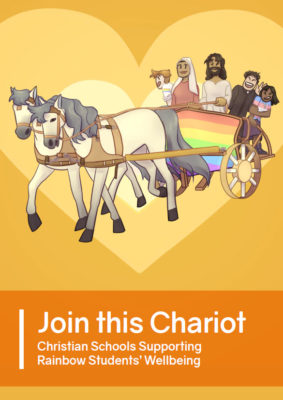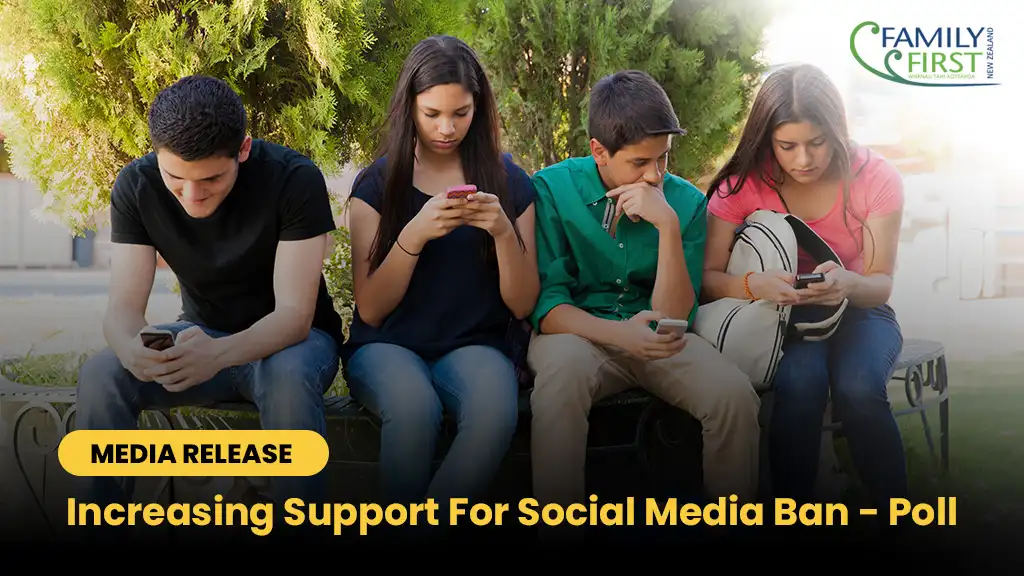 Commentary by Bob McCoskrie and board member Bruce Logan
Commentary by Bob McCoskrie and board member Bruce Logan
We’ve been made aware of a new resource designed primarily for faith-based schools by InsideOut.
InsideOut is a Rainbow Youth programme funded by the Ministry of Social Development which is being pushed under the banner of ‘anti-bullying’, and aimed at children as young as Year 7. Our children are indoctrinated with the message “Gender identity is a person’s own sense of identification as male, female, neither, both, or somewhere in between. Sometimes people get confused about the difference between gender and sex. Gender refers to the gender that someone identifies with, while sex is usually refers to the sex someone is assigned at birth.”
This new resource is ‘Join this Chariot: Christian Schools Supporting Rainbow Students’ Wellbeing’ – and is described as being a “carefully and very lovingly crafted theologically grounded educational resource” and “a taonga.”
The claim that the resource is “a truly compassionate narrative” is gobbledygook. Only people can be compassionate. The resource is neither theologically grounded nor carefully crafted.
Its Foreword quickly indicates that the resource is neither theologically grounded nor a Taonga.
What this precious resource provides is an exemplary reading of the Gospel text, ‘I came that they may have life, and have it abundantly . . .’ For just as Jesus is rebuking the Pharisees for not taking care of those for whom they are responsible, for instead acting as those who bring fear and potential harm into the lives of those most vulnerable, he is also insisting it is the human right of all to choose if they so desire, to ‘come out [sic] and to go find abundant pasture’!
This of course is a complete (and offensive) misrepresentation of the words of Jesus in John 10:9.
Further below are excerpts from the resource which you may find both amusing but also offensive and alarming.
WHY CHRISTIAN SCHOOLS WILL IGNORE THIS RESOURCE
(and why parents of students at these schools should check)
 State integrated and private faith-based schools have a designated special character which is mostly Christian (there are some Islamic schools also). In the case of Christian schools, they have a responsibility to uphold their Christian character. The character of these schools is being increasingly pressured by the mores of our time rather than those virtues intrinsic to the special character of a Christian school.
State integrated and private faith-based schools have a designated special character which is mostly Christian (there are some Islamic schools also). In the case of Christian schools, they have a responsibility to uphold their Christian character. The character of these schools is being increasingly pressured by the mores of our time rather than those virtues intrinsic to the special character of a Christian school.
A Christian school hardly needs to be told by the state that it must not discriminate; treat others as inferior to oneself. The New Testament makes that clear. However, the same Testament tells us we must be discerning; in day-to-day practice that has come to mean understanding the distinction between tolerance and affirmation.
The political concept of inclusion, if taken seriously, must also include, accept and “keep safe” those young Christians who believe in a biblical sexual ethic, and that sexual behaviour is sinful outside the protection of biblical marriage. These schools exist on the foundation of Scripture. Otherwise it has no special character worthy of note.
Few people would suggest that young people should not be treated with fairness and understanding. But neither fairness nor understanding demand in any Christian environment the skewing of Scripture to support sinful behaviour in the name of inclusion.
There is an essential underlying problem in that the writers of Inside out have a different understanding of what it means to be human than that presented in the Bible.
As we have previously stated, these types of programmes are wanting to politicise the sexualisation of school children under the guise of bullying programmes rather than deal with the school bullying issue as it should be dealt with. They are predominantly about promoting a LGBT-narrative.
READ MORE: To the Minister of Education: Keep ALL Students Safe From Bullying
This resource from InsideOut is not the authority on sexual ethics. The questions that parents should be asking are:
- Does the school actually reinforce the traditional Christian teaching that all sexual behaviour outside of marriage between a man and a woman is sinful? If not, why not?
- Is the school teaching the students the Gospel of Jesus Christ and its implications for behaviour, hope and meaning, and of course, sexual order and biological reality, or is it encouraging them to believe in the contemporary gospel of relativism presently articulated in the cult of diversity, inclusion and tolerance?
- Does the school teach a biblical theology of the person?
In his book What do you learn in School, Brian Watts states,
“…Christian education should teach our children to think from a biblical worldview. Our goal is to train a generation of young people who can build on God’s Word and who will be part of the solution to the coming crises in our culture.”
EXCERPTS FROM THE RESOURCE
(our emphasis added)
INTERSEX
The resource says “Around 2.3% of the world’s population is born with variations in sex characteristics (VSC) such as chromosomes and hormones that do not fit neatly into ‘male’ or ‘female’ categories. This is commonly known as intersex.” The truth is that in fewer than two out of every 10,000 births, a baby is born with ambiguous genitalia. Individuals with DSDs do not constitute a third sex.
Excerpts from HISTORICAL BACKGROUND
“According to professor Ngahuia Te Awekotuku, ‘sexuality was enjoyed in many forms. People chose partners of either sex for pleasure, and same-sex love was not condemned or vilified.”
“Takatāpui have experienced an ‘intersectional oppression’ from ‘puritanical and colonial history which has included the subjugation of Māori women, the suppression of gender and sexual fluidity, and the criminalisation of same-sex attraction and gender non-conformity’.”
(Bruce Logan) – This statement is so conflated it’s meaningless. The introduction of intersectionality dogma confuses, it certainly does not clarify anything. The idea that “puritanical and colonial history” has contributed to the subjugation of women is simply not borne out by any reasonable history of New Zealand.
Excerpts from “pride & sin”
“We think there’s a difference between pride as in ‘arrogance’, and pride as in ‘self esteem’… The Bible is against arrogance, ‘When pride comes, then comes disgrace; but wisdom is with the humble’ (Proverbs 11:2). However, it is supportive of healthy self-esteem based on who we are, not on what others think of us, ‘All must test their own work; then that work, rather than their neighbor’s work, will become a cause for pride’. (Galatians 6:4). Pride is not so much about the individual as feeling good about the community as a whole.”
(Bruce Logan) – Identity is entirely subjective. Identity is not declared by God who created us male and female. It’s also worth observing the distinction made by the resource between ‘arrogance’ and “self-esteem”. It’s a category error. “Arrogance” is a moral judgement while self-esteem is allegedly amoral. The writers don’t understand the distinction between the psychological notion of ‘self-esteem’ and the moral notion of ‘self-respect’. Self-esteem has no moral component at all and is based on how one feels about oneself. From a biblical perspective it not only does not solve the problem of pride, it makes it worse.
Excerpts from “RAINBOW AFFIRMING CULTURE, THEOLOGY AND FAITH”
“The long history of the church’s teaching against homosexuality went hand in hand with its teaching against women holding church office and people of colour as not worthy of being human… God, somehow, was always viewed as a male figure… Moreover, Jesus is also male and Jesus’ recognised disciples were all men. Another, and very important, factor that contributed to male domination and the downgrading of women, people of colour and people of the rainbow community,
“…our understanding of the Bible and the God that Jesus knew is a lot better now…we now know the interpretations of the Bible that degraded women, people of colour and the rainbow community were all biased and wrong. They were interpretations to protect white men…
“Jesus never said anything about our sexuality..”
(Bruce Logan) – This is an astonishingly amateurish attempt at interpreting Scripture. That Jesus, in his humanity, was male seems to be a handicap. To claim that we now know more about Jesus that he did about himself is arrogance on steroids. The verifiable reality is plainly evident. See Tom Holland’s Dominion (2020). Christianity is unique in its understanding of the equality between men and women. One of the reasons for its growth among the Romans of the third century, particularly women, was because they began to understand the foundation of that equality.
Excerpts from “A THEOLOGY OF INCLUSION”
The booklet includes a commentary by historian Peter Lineham
“there is no hierarchy of sins, and sin at its heart is rejection of God, not particular acts. Rather, it is what we do with our sexual and gender identity that matters. When we use it selfishly, when we exploit others or abuse ourselves, then we dishonour the image of God within us.”
Excerpts from “LOOKING AT THE BIBLE”
The resource discusses what they term as “clobber verses”, but their theological analysis is appalling.
The story of Sodom and Gomorroh (Genesis 18-19) is one example of this. This story is sometimes interpreted to mean sex between two men is bad, but another interpretation is that it’s about sexual violence, and violence towards guests not being okay
“Several verses in the Pauline Epistles (Romans 1:26-27; 1st Corinthians 6:9; 1st Timothy 1:10) are also often read as condemning sex between people of the same gender, especially men. However, the words that are often translated as meaning ‘men sleeping with men’ are notoriously complex to translate. What is widely agreed is that language like Paul’s referred to unequal sexual relationships between a powerful adult man and less powerful people, often slaves, male or female, who may have been teenagers or even children. Condemning this is more about forbidding abuse than it is about the gender of the humans involved.
Excerpts from “RAINBOW-ISH STORIES IN THE BIBLE”
“The story of Ruth and Naomi (in the book of Ruth), and David and Jonathan (in 1 Samuel) are both about life-long commitment between people of the same gender.”
Somehow a friendship between two males or two females is now unique and an indication of sexuality!
“Ruth and Naomi were not in an intimate relationship, but they had a deep commitment to each other. Ruth’s decision to marry Boaz (a rich land-owner) was more about finding a way to provide for herself and Naomi than it was about being in love with Boaz.”
In other words, Ruth married Boaz for the money – but was in love with another woman
“Jonathan and David were in a committed relationship that may have been sexual. Jonathan warned David that he was in danger from King Saul (Jonathan’s father), because Jonathan ‘took great delight in’ David. ‘Then Jonathan made a covenant with David, because he loved him as his own soul’ (1 Samuel 18:3). When David and Jonathan have to part for safety reasons, they kiss, ‘they kissed one another, and wept one with another, until David exceeded’ (1 Samuel 20:41, KJV). The word here translated as ‘exceeded’ literally means ‘become large’, i.e. David had an erection.”
This bizarre interpretation is both shocking and offensive. It continues…
Many modern translations have hidden this, instead saying ‘they kissed each other, and wept with each other; David wept the more’ (NRSV).
Yes – because biblical scholars have come to that same conclusion
The story of the Roman Centurion and his servant (Luke 7:1-10) is also a story of care and devotion between two men. The Roman Centurion goes outside of his culture and status to ask Jesus to heal his ‘pais’, which Jesus does, praising the centurion’s faith. The word ‘pais’ was commonly used at the time to refer to a younger person in a same-gender relationship.
(Bruce Logan) – Pais παῖς, παιδός, ὁ, ἡ can be translated variously child (can be either male or female) boy, youth. To suggest that it was “commonly used at the time to refer to a younger person in a same-gender relationship” is not supported by any authority. And even if it were so it would not give any authority to the relationship.
The resource goes on to say that the story of Philip and the eunuch in Acts 8:26-39,
“is where the name of this resource comes from. It is about a person who is a gender minority becoming a Christian after a conversation with Philip. In this interaction, both people were changed: the eunuch became a Christian, and Philip’s cultural prejudices about who is acceptable to God were challenged!”
The Ethiopian eunuch was not a “gender minority person”. To make that claim requires that a reader must read back from his or her predilection to the text. To identify ritual uncleanness with unworthiness to worship God is a strange reading of the text. But it does of course fit the ideology of the writers of InsideOut. The sheer unsubstantiated boldness of the claim exposes the limitations of the resource’s method of interpretation.
“Biblical scholars can only speculate about what biblical authors such as St. Paul and St. Peter would have thought, said, and done. We do know that they did not witness the beautiful range of rainbow identities or relationships increasingly out in the open today. We also know that scientific knowledge of the nature of sex, reproduction, and gender has developed significantly since then. Finally, we know they were humble enough to change their minds when Jesus confronted them about harmful behaviours in the name of God, and when they witnessed the outpouring of the Holy Spirit on groups they had previously excluded.
(Bruce Logan) – Certainly, our knowledge of the human body has increased. Physiologically we do know more about reproduction, and we probably have more insight into the psychological significance of sexual relationships. However, we are no more enlightened about the ethical realities of sexual activity than the writers of the Old and New Testaments. The use of “gender” here is ambiguous. It’s unclear whether it stands in for “biological sex” or it whether it reflects the thinking of transgender ideology. Re the statement “We do know that they did not witness the beautiful range of rainbow identities or relationships increasingly out in the open today.” The writers display little knowledge of the classical texts, for example Plato’s Symposium. The ancient writers witnessed and practised a wide range of sexual activity. However, they did not think same-sex intercourse “beautiful” as the Roman satirist Juvenal makes clear. The idea that sexual activity could be given an identity would have been a joke to the ancient mind. Neither Latin nor Greek had a word to separate and identify what we now call homosexuality or heterosexuality.
Excerpts from “GOD LOVES DIVERSITY”
..”male and female God created them’ (Genesis 1:27) could be another type of diversity, not a fixed list of possible identities64. In the book of Job, God never answers Job’s theological questions directly. The only answer Job gets is a series of poems on the power and range of creation. God’s answer is to show the wildness and variety of God’s world.
“There is also diversity in the range of ways God is described in the Bible, including both male and female images for all persons of the Trinity, i.e. God, Jesus and the Holy Spirit65. The wisdom of God is called ‘she’, and Jesus wanted to care for Jerusalem as ‘a hen gathers her chicks under her wings’ (Matthew 23:37). The Holy Spirit is grammatically feminine and neuter in the Hebrew and Greek of the Bible. Biblical symbols for God’s people are also rather gender-fluid: we are Christ’s (male) body and his (female) bride! The Bible does not have the fixed ideas about gender and relationships that modern Western Christianity often imposes on it.”
Jesus “never said anything about people and relationships that we would these days consider rainbow”
Excerpts from “PROFILES OF RAINBOW AND AFFIRMING CHRISTIANS
“The Madonna of Montevergine is an icon of the Virgin Mary, in the Abbey of Montevergine, in the Napoli area of Italy. According to popular belief, by miracle she saved two male lovers from death by homophobic violence in the year 1256”
(Bruce Logan) – This strange and convoluted explanation echoes the confusion behind the myth it attempts to explore. The Sanctuary of Montevergine, build adjacent to the Temple of Cybele was a strange fusion of Christian and pagan thought. The Madonna of Montevergine may well be the patron of the LGBTQ community. However, the story of the two same-sex lovers allegedly saved by her runs counter to any ancient or modern understanding of the Madonna. The story offers evidence for very little.
It is important that parents are aware of these resources and their content – especially parents who have chosen faith-based schools to avoid this type of material.




